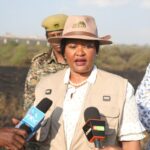
In a report, KWS noted that protecting wildlife has contributed to Kenya’s socio-economic development by supporting tourism which contributes about 10% of the national GDP.
KWS added that its efforts to protect wildlife have led to providing jobs, improving livelihoods, enhancing better infrastructure and significantly generating revenue.
The organisation said that during the year 2023/2024, it generated internal revenues of Ksh.7.6 billion from the previous year’s Ksh.5.3 billion.
It attributed the revenue collection to the adoption of the e-Citizen platform and integration of national park gates into the system which has eliminated revenue leakages and propelled the organization’s earnings.
KWS added that they have employed 1,274 rangers, the highest recruit numbers since the organization was founded in 1946.
“In addition to the ranger recruitment, 150 cadets are in the process of recruitment and will soon report to Law Enforcement Academy for 9-month training, enhancing operational efficiency and capacity to address conservation challenges,” read the report in part.
It further noted that 122 investment sites have been opened across various national parks, reserves, and conservation areas, projecting a rise in tourist visits.
Selected national parks are to be upgraded to premium status, promising increased revenue generation, enhanced visitor experiences, and global competitiveness in wildlife tourism.
Further, KWS said that it has developed infrastructure in less-visited parks to improve tourism in less-visited parks.
National parks and reserves among them Mt Elgon, Ruma in Homa Bay, Marsabit, Central Island in Turkana, Sibiloi in Marsabit, Ndere Island in Kisumu and Meru/Kora national parks have had access roads and airstrips refurbished.
KWS added that it introduced virtual tours and digital tourism experiences to attract a tech-savvy global audience.
It noted that 1,250 predator deterrence lights and predator-proof bomas have been distributed in predator-inhabited areas and conducted 2,000 elephant drives (aerial and ground) to manage human-wildlife conflict effectively.
It also said that 14 classrooms in high-human wildlife conflict areas have been built and Ksh.50 million offered to projects supporting education, water access, and healthcare.
Water resource development has also been fostered by creating 300 water pans and drilling boreholes in arid regions to support community livelihoods and reduce conflicts.
Families who lost their loved ones through wildlife incidents have received Ksh.2,914,100 in compensation.
Similarly, KWS has managed to translocate 24 rhinos and 53 elephants to key habitats such as Loisaba and Sera Conservancies and Aberdare National Park.
It has also established two new black rhino founder populations in line with the Black Rhino Recovery and Action Plan.
“Kenya has contained poaching and illegal wildlife trade, which nearly wiped out our elephants and rhinos in the 1980s. In the last five years, poaching has been significantly reduced, with the year 2020 recording no rhino poaching incident,” added KWS.
“Endangered species recovery efforts have stabilized and even increased the populations of charismatic and iconic wild animals. As a result, Kenya now boasts the third-largest rhino population and the fourth-largest elephant population in Africa.”
The Ministry of Tourism and Wildlife has committed to support KWS in reducing reliance on the National Treasury through a robust financial sustainability model.
The Bottom-Up transformation agenda was introduced by President William Ruto in the run-up to the 2022 General Election, aiming to improve livelihoods across all sectors.
The agenda, now highly promoted yet censured by Kenyans, is anchored on five main pillars including Agricultural Transformation, Micro, Small and Medium Enterprise (MSME) Economy, Healthcare, Housing and Settlement and Digital Superhighway and Creative Industry.



















